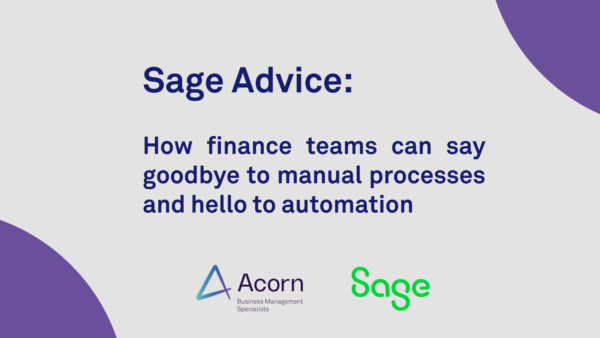How finance teams can say goodbye to manual processes and hello to automation
Is your finance team spending too much time on manual processes?
Could automation give you more time?
Ideally, as the CFO or financial manager, your finance team has a strategic role, supporting you, the CEO and the leadership teams to make critical business decisions that shape the future.

But what if you don’t have time to do that necessary work?
What if you’re spending 10 or more days on monthly financial closes, reviewing and reconciliating your records?
You might have monthly closes, quarterly closes, or annual audits to deal with.
Today for most businesses, there’s a lot of repetitive work involved to get through those cycles due to time-consuming manual processes.
In this article, we highlight how you and your finance team can say farewell to those manual processes courtesy of automation.
Challenges of manual processes for finance teams
Managing processes can be time-consuming for finance teams, especially with issuing and processing invoices, keeping track of budgets, and creating financial reports.
As your business grows and processes and reporting become more complex, it’s common to waste incredible amounts of time with manual data entry, unruly spreadsheets and time-consuming workarounds.
No matter how skilled your finance department may be, any system that relies on manually inputting data from paper is slow and subject to human error.
Every time a piece of paper changes hands, you introduce an opportunity to misread, misplace or misunderstand something.
For a company that handles tens of thousands of invoices per month, even a tiny margin of error can result in huge losses.
Manual processing also leads to a lack of control and visibility, leaving you unable to make informed decisions to effectively lead your team, creating an environment vulnerable to fraud.
How spreadsheets are slowing the financial close process
Spreadsheets are cheap and flexible.
We all know how they work. And in lots of cases, they can be really useful.
However, a significant problem with spreadsheets is that you must enter calculations as formulas, so you need to learn the correct formula for each calculation you need.
And that can be a big problem when it comes to dealing with your financial close processes.
Training for this takes time, and some users still find them challenging.
If you enter a formula or data into a cell incorrectly, all calculations related to that cell will also be wrong.
Large spreadsheets can inevitably have some input or formula errors, which can be time-consuming to find and lead to severe consequences if uncorrected.
You can add spreadsheet on top of spreadsheet as you need them.
But as your business grows, your workbooks will become more complex, leading to more time wasted on maintenance.
The more complex spreadsheets are, the more of a problem it can be for anyone to change, modify and even destroy data.
If you lock them down, they lose the very flexibility that made you use them in the first place.
Why automation can speed things up
By incorporating automation into your financial processes, you can significantly reduce close days, increase agility, lower costs, improve productivity, reduce delays, minimise errors, and ultimately give your team more time to focus on strategy, business growth and success.
Automation can decrease the financial close to a more manageable three to five days and has the potential to get rid of the close entirely.
One day in the future, you might be able to automate all the processes within your finance team fully. Automation makes a future possible where real-time data removes the need for a close—as you’re always current.
Software as a Service (SaaS) businesses that might have only been able to forecast renewals quarterly can trend-spot in real time, flagging material changes.
Perhaps most importantly, automating routine tasks of assurance and accounting workflows frees up your finance team to focus on more strategic activities.
How to adopt automation for financial processes
If you’re looking at getting automation going, here are some steps you might want to take.
1. Understand what kind of automation you need
Every business is different, and it’s crucial to get the best value. It’s essential to understand what area of your finances could do most with automation.
You could focus on reconciliation, for example, a massive drain of resources for any finance office.
Reconciliation is a process where you must match the entry in the bank account with the relevant invoice in your system once you receive a payment.
Why not automate reconciliation?
With some types of financial management software, it’s possible to create rules where regular payments automatically get matched to their invoices.
Additionally, artificial intelligence (AI) means you can match up one-off or otherwise discrete payments.
Of course, someone from your team will still have to check the reconciliation.
Still, there’s a considerable time and labour difference between peering at two lists, matching things up, and simply checking that an existing reconciliation is correct.
Automation could allow you to import statements from your financial institutions and automatically reconcile them in minutes when managing your cash.
You’d be able to quickly spot exceptions, manage bank errors, monitor for fraud, and maintain accurate cash balances.
2. Develop a business case
When looking at automation within departments, you should question how economically viable opportunities are.
You should investigate what the return on investment would be.
Get relevant stakeholders in from the departments in question and try and create a business case.
3. Get management buy-in
You need to get information straight from stakeholders on what they understand when it comes to automation and how it would be able to benefit them.
You and other leadership team members should help the wider business understand what automation can do and how it could make their working lives easier, letting them focus on more critical, less repetitive tasks.
4. Support IT in setting up the systems
The IT team can provide technical expertise to ensure automation implementation runs smoothly and at the right speed.
The technical leadership needs to start small with automation, get the business used to the technology, and expand it when it gets used to the changes.
With the cloud, your finance team can become more agile and faster, gaining efficiencies through the time you save by removing time-intensive manual tasks.
To extract value from automation, it will be up to you to assess commercial models, look at the risks, recognise and account for value, and apply controls and governance.
5. Get results
Create a clear automation roadmap. You’ll have to work closely with your people, who will drive the use of new technology.
With the tech in place, you’ill need to work at measuring your progress and ask a few questions of your finance team:
- How are you using automation, and are you doing it right?
- How effective are your new processes?
- Are they leading to the productivity and efficiency improvements you expect?
- What outcomes do you see with the new technology?
- How can you get business metrics for your intended goals?
AI forecasting the future
Automation is a subcategory of AI that follows pre-programmed rules to run processes.
However, we’re bound to see more advanced forms of AI in the future as systems apply self-learning capability through machine learning.
The future will see forward-looking finance teams use data science and AI to look into the future, using real-time insights and AI-powered forecasting.
Today, AI can help support small businesses with cash flow forecasting, while, as we’ve said, larger medium-sized SaaS businesses in specific industries might use AI to forecast renewals.
Members of your finance teams can use AI to build patterns of understanding, identifying transactions flowing through the business that don’t match these patterns—in real time.
Your team will have confidence when reviewing hundreds of thousands of transactions a month. Humans cannot review all of that manually.
Aaron Harris, chief technology officer at Sage, says: “The real value in AI-powered forecasting isn’t that it’s more accurate than humans; the real power is that AI can do it continuously, and basically for free.”

